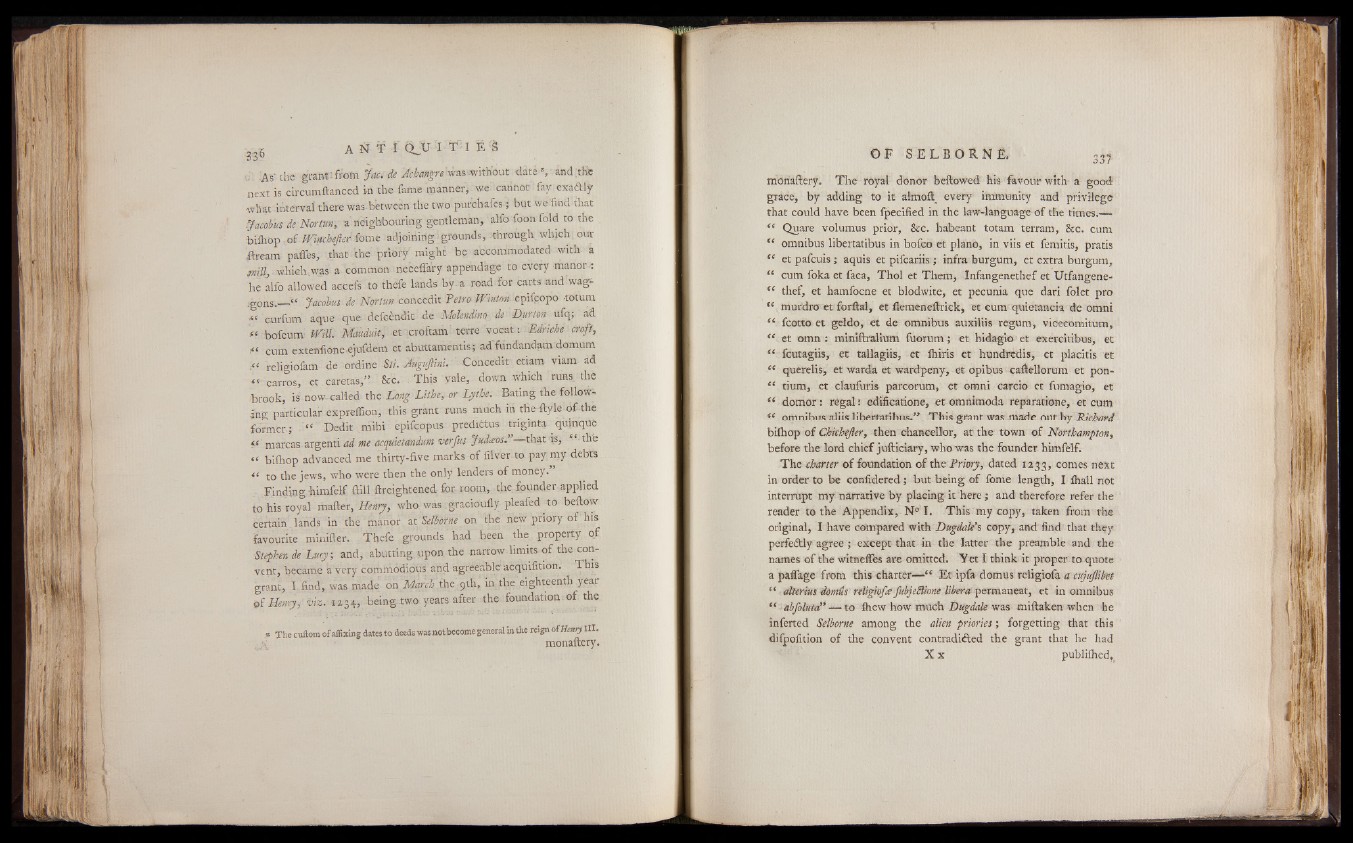
.;; grant - from Jdc. de Achangve was •‘witlfout date 2, and ;thfc
next is circuniftanced in the fame manner j we - catifiot fay; exadtly
:\yi%t interval there Was between the two purchafes-; but we find that
Jacobus de Nortun, a neighbouring gentleman, alfo foon fold to the
bilhop ...of Wmhefiet- feme adjoining :■ grounds, through, which : our
ftream paffes, that-the prior/ might be; accommodated with, a
Will, which .was . a common neceffary appendage to every manor *
he alfo allowed accefs to thefe lands by a road-tor carts and waggons.—
“ Jacobus de Nortun concedit Petro IVintonepifpopo totum
.it curium aque que defcendit de Molendinq de Durton ufq; ad
f t bofcum Will. Mauduit, et croftatn ter-re vocai:: Ednche croft,
:« cum extersfione.ejufdem et abuttamentis; ad fundandam domum
.« religiofam de ordine Sli. Auguftini. 'Concedit etiam viam ad
« carros, et caretas,” &c. This vale, down which runs, the
brook, is now-called the Long Lithe, or Lythe. Bating the following
particular expreflion, this grant runs much in the llyle of the
former; .i«"Dedit mihi epifcopus predi&us triginta «luihqde
« marcas argenti ad me acquietandum verfus Judaos.’ that -is, “ the
“ bilhop advanced me thirty-five marks of lilver to pay; my debts
to the jews, who were then the only lenders of money.
Finding-himfelf Hill ftreightened for room, the. founder applied
to his royal mailer, Henry, who was ’gracioufly pleafed to- bellow
certain lands in the manor at SdPprne on the new priory of his
favourite minifter. Thefe grounds had been the property of
Stephen de Lucy ; and, abutting, upon the narrow limits of the convent,
became a very commodious and agreeable acquifition. This
grant, I find, was made on March the 9th, in the eighteenth year
of Henry, viz. 1234, being two years after the foundation, of the
* The cultom of affixing dates to deeds was not become general in the reign of t o o - III.
,/■ ; mon a fte ry .
monaftery. The royal donor beftowed his favour with a good
grace, by adding to it almoft every immunity and privilege
that could have been Ipecified in the law-language of the times.—
££ Quare volumus prior, &c. habeant totam terram, &c. cum
" omnibus libertatibus in bofco et piano, in viis et femitis, pratis
“ et pafcuis; aquis et pifcatiis; infra burgum, et extra burgum,
“ cum foka et faca, Thol et Them, Infangenethef et Utfangene-
“ thef, et hamfocne et blodwite, et pecunia que dari folet pro
“ murdro et forftal, et flemeneftrick, et cum quiecancia de omni
“ fcotto et geldo, et de omnibus auxilivs regum, vicecomitum,
“ et omn: miniftralium fuorum; et hidagio et exercitibus, et
££ fcutagiis, et tallagiis, et Ihiris et hundredis, et placitis et
“ querelis, et warda et wardpeny, et opibus caftellorum et pon-
“ tium, et claufuris parcorum, et omni carcio et fumagio, et
“ domor: regal: edificatione, et omnitnoda reparatione, et cum
££ omnibus aliis libertatibus.” This grant was made out by Richard
bilhop of Chichejler, then chancellor, at the town of Northampton,
before the lord chief jufticiary, who was the founder himfelf.
The charter of foundation of the Priory, dated 1233, comes next
in order to be confidered; but being of feme length, I lhall not
interrupt my narrative by placing it here; and therefore refer the
reader to the Appendix, N° I. This my copy, taken from the
original, I have compared with Dugdale’s copy, and find that they
perfedtly agree; except that in the latter the preamble and the
names of the witneffes are omitted. Yet I think it proper to quote
a pafiage from this charter— ££ Et ipfa domus religiofa a cujujlikt
“ alterius domus religiofa fubjeSKone libera permaneat, et in omnibus
“ abfoluta" — to Ihew how much Dugdale was miftaken when he
inferted Selborne among the alien priories; forgetting that this
difpoiition of the convent contradifted the grant that he had
X X publifhed,(